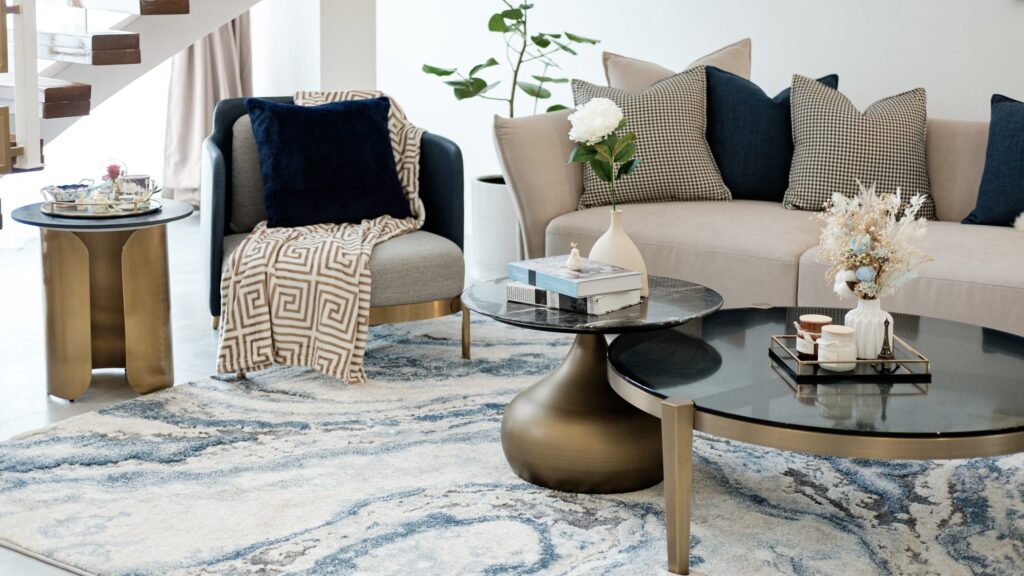- Rugs can enhance the aesthetic appeal and comfort of any room.
- There are diverse types of rugs suitable for different areas and purposes.
- Choosing the right carpet involves considering material, size, and style.
The Power of Rugs in Interior Design
Rugs are powerful design elements that can significantly elevate the look and feel of a room. From adding warmth to defining spaces, rugs are versatile pieces that play both functional and aesthetic roles. Rugs provide a foundation for furniture and help create various zones within an open-plan space. According to Architectural Digest, strategically placing rugs can make your home cozy and inviting, giving it a well-designed and coherent appearance.
Types of Rugs and Their Uses
There is a wide variety of rugs available, each serving different purposes. One of the most convenient options available today is washable rugs, which combine ease of maintenance with style. Understanding the types of rugs can help you make informed choices:
- Area Rugs: Perfect for living rooms and bedrooms, they define spaces and add comfort underfoot. These rugs can anchor your furniture and bring all the décor elements together, providing a cohesive look to your room. They are usually larger and can accommodate a variety of furniture arrangements.
- Runner Rugs: Ideal for hallways and stairs, adding texture and warmth to long, narrow spaces. Runner rugs can lead guests through different areas of your home and add a touch of style to spaces that might otherwise feel bland or overlooked. They also help to reduce noise and protect your floors from high traffic.
- Outdoor Rugs: Made from durable materials, these are perfect for patios and high-traffic areas. These rugs are designed to withstand the elements and offer comfort and style to outdoor living spaces. Outdoor rugs can transform your patio, deck, or balcony into an inviting extension of your home.
Choosing the Right Material
Rug materials vary widely, each offering specific benefits. For instance, Houzz suggests that wool rugs are durable and luxurious, providing resilience against wear and tear and natural stain resistance due to the fiber’s composition. On the other hand, synthetic rugs, made from materials like polypropylene or nylon, offer an affordable option that is easy to clean and maintain. These artificial options are great for homes with pets or children as they can withstand frequent cleanings and are often less expensive to replace. Understanding the pros and cons of each material can help you choose the best rug for your needs, depending on the traffic and usage of the space.
Sizing Your Rug Appropriately
Getting the size right is crucial for the rug’s intended purpose. A rug that’s too small or too large can disrupt the room’s harmony. When choosing a rug size:
- Measure your space to ensure the carpet complements the room’s layout. Ensure the rug fits the intended area and is manageable and manageable.
- In living rooms, rugs should ideally fit under all the essential furniture pieces. This means that the front legs of your sofa and chairs should rest on the carpet to create a unified look.
- In dining rooms, rugs should extend beyond the chairs when pulled out. This ensures that the carpet serves its purpose even when the chairs are in use and helps to protect your floor from scratches.
Color and Pattern Choices
The color and pattern of a rug can influence the mood and style of a room. Bold patterns or bright colors can create a focal point, drawing attention to the center of the room and setting the tone for the décor. These can be especially effective in rooms with muted or monochromatic walls, where the rug is the main attraction. Conversely, neutral tones can blend seamlessly with existing decor, allowing other elements like artwork or furniture to shine. Considering the room’s color scheme and how the rug will interact with other components is essential, ensuring the overall design feels balanced and harmonious.
Maintaining Your Rug
Regular care can prolong the lifespan of your rug. Regularly vacuuming assists in eliminating dust and dirt to prevent them from getting trapped in the fibers. It is important to remove stains promptly to prevent long-lasting discoloration; softly blot stains instead of rubbing them to avoid making them permanent. Occasionally, professional cleaning can rejuvenate your rug, restoring its original vibrancy. For high-traffic areas, consider rugs with stain-resistant properties. Investing in a high-quality rug pad can also help keep your rug in place, reduce wear and tear, and add an extra cushioning layer.
Rug Placement Tips
Where you place your rug matters; placing a large rug under all major furniture can anchor the room, creating a unified look.This strategy is effective in living rooms and dining areas when you need to delineate a particular area. On the other hand, a smaller rug can highlight a particular area, like a reading nook or a coffee table setup. In open-plan spaces, rugs can help demarcate different functional areas, such as separating the dining area from the lounge space. Experiment with angles and spacing to find the most pleasing arrangement.
Conclusion
Rugs are not just decorative pieces but essential in creating a cohesive and comfortable home. Choosing the right rug involves considering the material, size, color, pattern, and placement. Rugs can serve multiple purposes, from comfort and warmth to showcasing style. With thoughtful selection and care, a rug can transform any space into a stylish and inviting haven. Whether you opt for luxurious wool or practical synthetic fibers, the right rug can make all the difference in your home’s overall ambiance.

Asad Arshad, a prolific author of over 50+ websites across various niches, is open to collaboration opportunities. 🌐 For guest posts, reach out to him to benefit from his vast expertise and connect with a diverse audience. 📬




